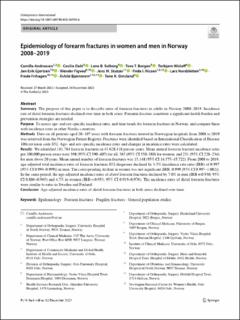| dc.contributor.author | Andreasen, Camilla | |
| dc.contributor.author | Dahl, Cecilie | |
| dc.contributor.author | Solberg, Lene Bergendal | |
| dc.contributor.author | Borgen, Tove Tveitan | |
| dc.contributor.author | Wisløff, Torbjørn | |
| dc.contributor.author | Gjertsen, Jan-Erik | |
| dc.contributor.author | Figved, Wender | |
| dc.contributor.author | Stutzer, Jens-Meinhard | |
| dc.contributor.author | Nissen, Frida Igland | |
| dc.contributor.author | Nordsletten, Lars | |
| dc.contributor.author | Frihagen, Frede | |
| dc.contributor.author | Bjørnerem, Åshild Marit | |
| dc.contributor.author | Omsland, Tone Kristin | |
| dc.date.accessioned | 2024-02-15T13:05:42Z | |
| dc.date.available | 2024-02-15T13:05:42Z | |
| dc.date.created | 2023-12-12T11:19:02Z | |
| dc.date.issued | 2023 | |
| dc.identifier.issn | 0937-941X | |
| dc.identifier.uri | https://hdl.handle.net/11250/3118001 | |
| dc.description.abstract | Summary
The purpose of this paper is to describe rates of forearm fractures in adults in Norway 2008–2019. Incidence rate of distal forearm fractures declined over time in both sexes. Forearm fracture constitute a significant health burden and prevention strategies are needed.
Purpose
To assess age- and sex-specific incidence rates, and time trends for forearm fractures in Norway, and compare these with incidence rates in other Nordic countries.
Methods
Data on all patients aged 20–107 years with forearm fractures treated in Norwegian hospitals from 2008 to 2019 was retrieved from the Norwegian Patient Registry. Fractures were identified based on International Classification of Disease 10th revision code S52. Age- and sex-specific incidence rates and changes in incidence rates were calculated.
Results
We identified 181,784 forearm fractures in 45,628,418 person-years. Mean annual forearm fracture incidence rates per 100,000 person-years were 398 (95% CI 390–407) for all, 565 (95% CI 550–580) for women, and 231 (95% CI 228–234) for men above 20 years. Mean annual number of forearm fractures was 15,148 (95% CI 14,575–15,722). From 2008 to 2019, age-adjusted total incidence rates of forearm fractures S52 diagnoses declined by 3.5% (incidence rate ratio (IRR) of 0.997 (95% CI 0.994–0.999)) in men. The corresponding decline in women was not significant (IRR: 0.999 (95% CI 0.997–1.002)). In the same period, the age-adjusted incidence rates of distal forearm fractures declined by 7.0% in men (IRR = 0.930; 95% CI 0.886–0.965) and 4.7% in women (IRR = 0.953; 95% CI 0.919–0.976). The incidence rates of distal forearm fractures were similar to rates in Sweden and Finland.
Conclusion
Age-adjusted incidence rates of distal forearm fractures in both sexes declined over time. | en_US |
| dc.language.iso | eng | en_US |
| dc.publisher | Springer | en_US |
| dc.rights | Navngivelse-Ikkekommersiell 4.0 Internasjonal | * |
| dc.rights.uri | http://creativecommons.org/licenses/by-nc/4.0/deed.no | * |
| dc.title | Epidemiology of forearm fractures in women and men in Norway 2008–2019 | en_US |
| dc.type | Journal article | en_US |
| dc.type | Peer reviewed | en_US |
| dc.description.version | publishedVersion | en_US |
| dc.rights.holder | Copyright 2023 The Author(s) | en_US |
| cristin.ispublished | true | |
| cristin.fulltext | original | |
| cristin.qualitycode | 1 | |
| dc.identifier.doi | 10.1007/s00198-023-06990-6 | |
| dc.identifier.cristin | 2212250 | |
| dc.source.journal | Osteoporosis International | en_US |
| dc.identifier.citation | Osteoporosis International. 2023 | en_US |

